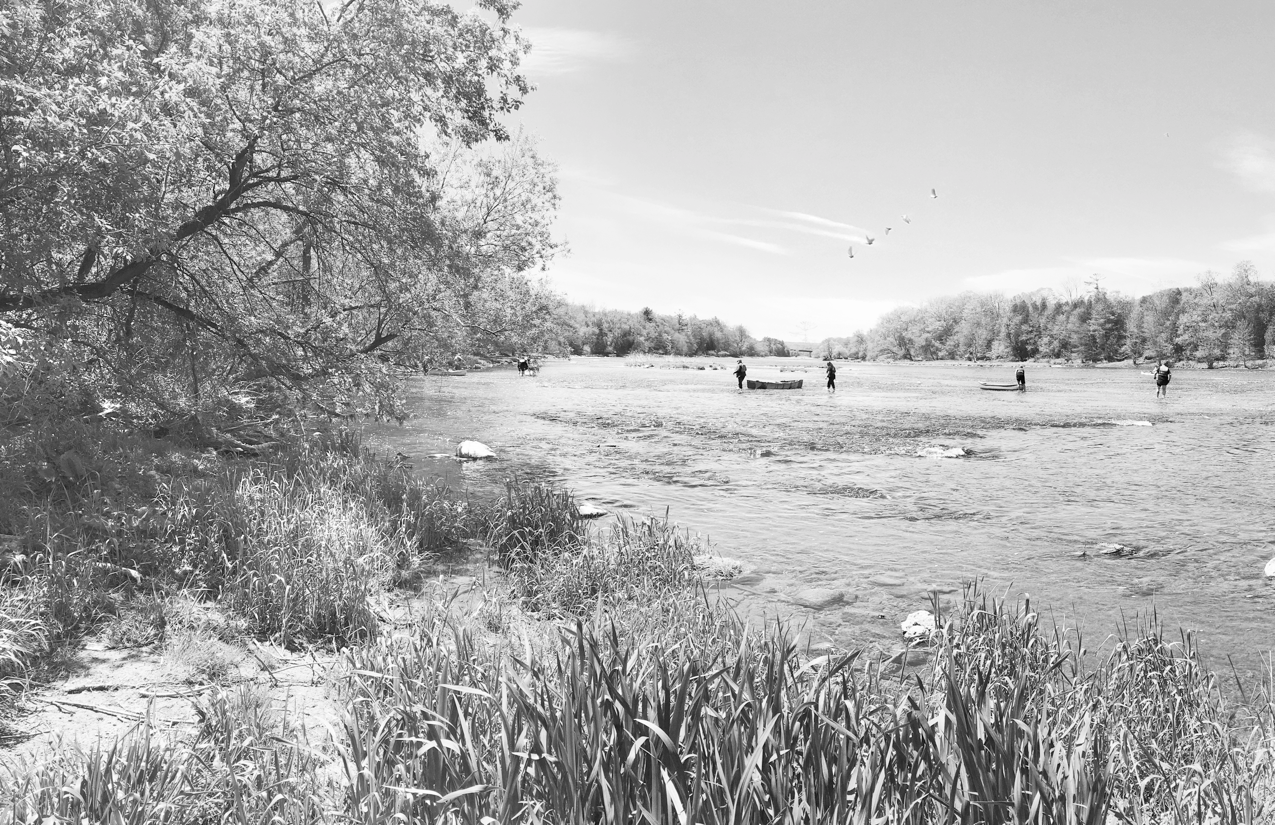
Of the thesis entitled: Guiding the Grand: Journeying into the Grand River’s Diverse Histories
The
Grand
River
is
a
dynamic
force
that
acts
on
and
within
the
landscape
of
its
watershed.
Through
the
course
of
an
eleven-thousand-year
relationship
with
humanity,
its
identity
has
evolved
most
dramatically
in
the
last
two
hundred
years.
Human
understanding
of
the
river
has
gone
from
prosperity
during
early
settlement,
to
adaptation
under
pressures
of
increasing
mid-century
flooding
and
drought,
and
now,
toward
a
passive
stance
that
views
the
river
as
a
valuable
resource
before
an
active
ecosystem.
This
most
recent
attitude
wavers
only
when
the
river
swells
and
rushes
to
remind
us
of
its
inexorable
nature;
a
power
that
humanity
has
historically
fought
to
obtain
control
over.
This thesis work is inspired by the willful words of geographer J.G. Nelson of the University of Waterloo’s Heritage Research Centre; “when people understand and appreciate the long history and special qualities of [the Grand River’s] landscapes, they will be more supportive of their conservation and stewardship”[i]. It is aimed at building on the individual’s relationship with the river, and seeks traction through the underutilized tourism industry of the Grand River. Currently, a handful of paddling and rafting outfitters service the lower reaches of the river, providing guided tours with limited historical content. Besides this, the GRCA has installed a number of heritage plaques within the watershed to mark a significant person, place or event on the river, however, these do little to adequately reveal the complexities of its history. This thesis proposes an alternative to the fragmented private services and prescriptive plaques, and, instead, uses architectural and landscape design to unify the river and animate aspects of the landscape’s past. The meaningful histories of identity, use and occupation on the Grand River become the basis for designs that draw people into it.
Operating as a guidebook to paddling the Grand River, this thesis is organised into a series of five day-trips to be undertaken in a canoe or kayak downstream. The journey begins central to the watershed, at the Shand Dam north of Fergus, and finishes at an abandoned stone mill near Glen Morris. Each trip accounts for 3-6 hours of water travel combined with several portaging stints, arriving by the end of each day at a themed site and campground; Displacing, Unearthing, Restoring, Gathering and Racing the Grand, in sequence. The themes explore aspects of the Grand River’s natural and cultural histories, engaging existing and revived qualities at each site, and encouraging moments of reflection along the journey. In order to experience the river, and to develop an immersive relationship with the capacity to learn from it, this thesis proposes that one must occupy the landscape the same way that the river does – physically, dynamically, and continuously.
[i] Nelson, J. G., ed. The Grand River Watershed: A Heritage Landscape Guide. Waterloo: Heritage Resources Centre, University of Waterloo, 2003, 3.
Supervisor:
Jane Hutton, University of Waterloo
Committee Members:
Rick Andrighetti, University of Waterloo
Rick Haldenby, University of Waterloo
External Reader:
Barbara Veale, Conservation Halton
The
committee
has
been
approved
as
authorized
by
the
Graduate
Studies
Committee.
The
Defence
Examination
will
take
place:
Tuesday,
August
28,
2018
10:00
AM
ARC
2026
A
copy
of
the
thesis
is
available
for
perusal
in
ARC
2106A.